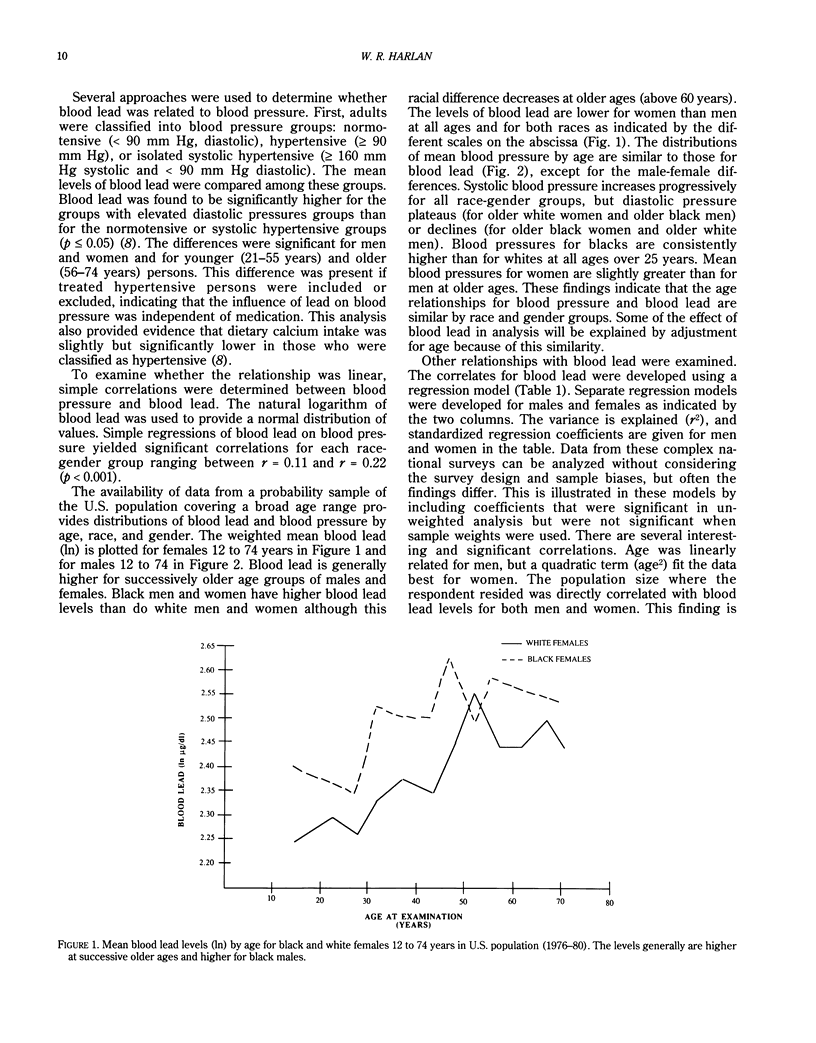Abstract
Numerous observations have indicated a relationship between moderate or heavy lead exposure and high blood pressure. To determine whether low-level lead exposure is related to blood pressure in the U.S. population, we analyzed data from the National Health and Nutrition Examination Survey II for persons 12 to 74 years of age. Significant correlations were found between blood lead and blood pressure for each race-gender group, and blood lead levels were significantly higher in groups with high diastolic blood pressure (greater than 90 mm Hg). Multiple stepwise regression models were developed to predict blood pressure. After adjusting for age, race, and body mass index, blood lead levels were significantly related to systolic and diastolic pressures in males but not in females. These findings and those from other studies confirm the relationship of blood lead and blood pressure at relatively low levels commonly observed in the general population. The strength and importance of this relationship require further study through epidemiologic and metabolic investigations.
Full text
PDF




Selected References
These references are in PubMed. This may not be the complete list of references from this article.
- Annest J. L., Pirkle J. L., Makuc D., Neese J. W., Bayse D. D., Kovar M. G. Chronological trend in blood lead levels between 1976 and 1980. N Engl J Med. 1983 Jun 9;308(23):1373–1377. doi: 10.1056/NEJM198306093082301. [DOI] [PubMed] [Google Scholar]
- Batuman V., Landy E., Maesaka J. K., Wedeen R. P. Contribution of lead to hypertension with renal impairment. N Engl J Med. 1983 Jul 7;309(1):17–21. doi: 10.1056/NEJM198307073090104. [DOI] [PubMed] [Google Scholar]
- Beevers D. G., Erskine E., Robertson M., Beattie A. D., Campbell B. C., Goldberg A., Moore M. R., Hawthorne V. M. Blood-lead and hypertension. Lancet. 1976 Jul 3;2(7975):1–3. [PubMed] [Google Scholar]
- Bennett W. M. Lead nephropathy. Kidney Int. 1985 Aug;28(2):212–220. doi: 10.1038/ki.1985.143. [DOI] [PubMed] [Google Scholar]
- Cooper W. C., Wong O., Kheifets L. Mortality among employees of lead battery plants and lead-producing plants, 1947-1980. Scand J Work Environ Health. 1985 Oct;11(5):331–345. doi: 10.5271/sjweh.2215. [DOI] [PubMed] [Google Scholar]
- Harlan W. R., Hull A. L., Schmouder R. L., Landis J. R., Thompson F. E., Larkin F. A. Blood pressure and nutrition in adults. The National Health and Nutrition Examination Survey. Am J Epidemiol. 1984 Jul;120(1):17–28. doi: 10.1093/oxfordjournals.aje.a113870. [DOI] [PubMed] [Google Scholar]
- Harlan W. R., Landis J. R., Schmouder R. L., Goldstein N. G., Harlan L. C. Blood lead and blood pressure. Relationship in the adolescent and adult US population. JAMA. 1985 Jan 25;253(4):530–534. doi: 10.1001/jama.253.4.530. [DOI] [PubMed] [Google Scholar]
- Mahaffey K. R. Nutritional factors and susceptibility to lead toxicity. Environ Health Perspect. 1974 May;7:107–112. doi: 10.1289/ehp.747107. [DOI] [PMC free article] [PubMed] [Google Scholar]
- McCarron D. A., Morris C. D., Henry H. J., Stanton J. L. Blood pressure and nutrient intake in the United States. Science. 1984 Jun 29;224(4656):1392–1398. doi: 10.1126/science.6729459. [DOI] [PubMed] [Google Scholar]
- McMichael A. J., Johnson H. M. Long-term mortality profile of heavily-exposed lead smelter workers. J Occup Med. 1982 May;24(5):375–378. doi: 10.1097/00043764-198205000-00008. [DOI] [PubMed] [Google Scholar]
- Moreau T., Orssaud G., Juguet B., Busquet G. Plombémie et pression artérielle. Premiers résultats d'une enquête transversale de 431 sujets de sexe masculin. Rev Epidemiol Sante Publique. 1982;30(3):395–397. [PubMed] [Google Scholar]
- Pirkle J. L., Schwartz J., Landis J. R., Harlan W. R. The relationship between blood lead levels and blood pressure and its cardiovascular risk implications. Am J Epidemiol. 1985 Feb;121(2):246–258. doi: 10.1093/oxfordjournals.aje.a113995. [DOI] [PubMed] [Google Scholar]
- Pocock S. J., Shaper A. G., Ashby D., Delves T., Whitehead T. P. Blood lead concentration, blood pressure, and renal function. Br Med J (Clin Res Ed) 1984 Oct 6;289(6449):872–874. doi: 10.1136/bmj.289.6449.872. [DOI] [PMC free article] [PubMed] [Google Scholar]
- Pounds J. G. Effect of lead intoxication on calcium homeostasis and calcium-mediated cell function: a review. Neurotoxicology. 1984 Fall;5(3):295–331. [PubMed] [Google Scholar]
- Webb R. C., Winquist R. J., Victery W., Vander A. J. In vivo and in vitro effects of lead on vascular reactivity in rats. Am J Physiol. 1981 Aug;241(2):H211–H216. doi: 10.1152/ajpheart.1981.241.2.H211. [DOI] [PubMed] [Google Scholar]
- Weiss S. T., Muñoz A., Stein A., Sparrow D., Speizer F. E. The relationship of blood lead to blood pressure in a longitudinal study of working men. Am J Epidemiol. 1986 May;123(5):800–808. doi: 10.1093/oxfordjournals.aje.a114309. [DOI] [PubMed] [Google Scholar]
- Williams B. J., Griffith W. H., 3rd, Albrecht C. M., Pirch J. H., Hejtmancik M. R., Jr Effects of chronic lead treatment on some cardiovascular responses to norepinephrine in the rat. Toxicol Appl Pharmacol. 1977 Jun;40(3):407–413. doi: 10.1016/0041-008x(77)90068-0. [DOI] [PubMed] [Google Scholar]


